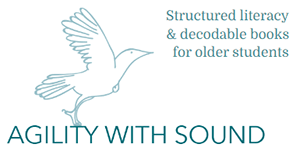Agility with Sound is an integrated and complete literacy resource
for older students, Years 5 – 10.
It has four broad but overlapping components:
1. Decoding, spelling and remembering words:
Matching spelling pattern to pronunciation, grapheme to phoneme, and vice versa, 1:1, to
figure out and remember all words to read and spell. This requires well-developed
phonological awareness, viz:
– The ability to isolate and identify phonemes in words,
– Phonics knowledge and pattern recognition,
– Efficient blending strategies.
These skills need to become instinctive, automatic, rapid, and eventually unconscious.
Relevant resources in Agility with Sound:
Isolate and identify phonemes: letter tiles, main Wordchain games.
Phonics knowledge: letter tiles, Wordchain, fluency sheets, sliders.
Pattern recognition and efficient blending strategies: fluency sheets, challenge sheets,
puzzles, sliders, Wordchain fluent blending section.
2. Self-teaching:
It is not possible to directly teach everything; students must develop the ability to self-teach.
This embraces the skills involved in figuring out and remembering new words, new spelling
patterns, new vocabulary, new knowledge, new grammatical structures and text features,
rapidly and instinctively, in the process of reading.
Relevant resources in Agility with Sound:
Wordchain, comprehension scripts and decodable books.
3. Comprehension:
Developing the areas of knowledge and the myriad ways of thinking to extract meaning from
text, most especially inferential skills.
Relevant resources in Agility with Sound:
Comprehension scripts, The Sentence Book, and the comprehension, vocabulary building,
critical thinking and writing resource (AwS Digital).
4. Writing:
Developing an understanding of the structure of sentences, paragraphs and text as the basis
of accurately, fluently and concisely expressing information, thoughts and ideas.
Relevant resources in Agility with Sound:
The Sentence Book, and the comprehension, vocabulary building, critical thinking and
writing resource (AwS Digital), Wordchain for spelling.
These skills are interactive, but also hierarchical and sequential. Excellent writing depends
on comprehension of the subject matter, deep comprehension requires self-teaching
proficiency, self-teaching relies on the skills involved in instant and unconscious recognition
of words.
Note that most resources build most skills to some extent. The fluency sheets reinforce
phonics knowledge, the books reinforce pattern recognition. Other areas of literacy
development, such as vocabulary building, back-ground knowledge and speaking skills, are
developed in multiple aspects of the whole.
This resource is for all students who need to develop the skills to succeed in NCEA 1,
and it lays the foundation for NCEA level 2.

